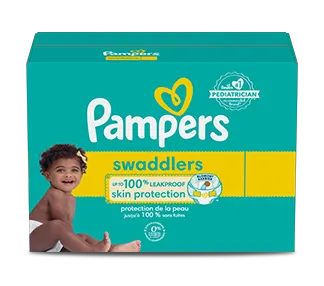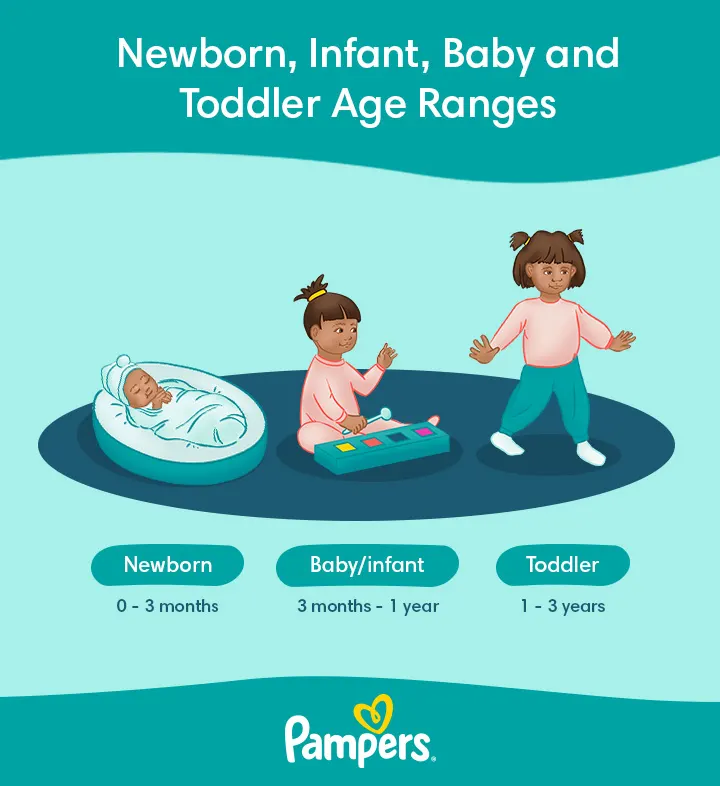About Newborn, Infant, Baby, and Toddler Age Ranges and Stages
From the moment of birth to the first day of preschool, your little one may be referred to as a newborn, baby, infant, or toddler. But when does your little one graduate from being a newborn to becoming a baby, and when does toddler age start? While there are no fixed definitions or age ranges for the terms, newborn, baby, infant, and toddler, we've put together some useful information to help you differentiate between these stages and understand the developmental changes that typically occur during each phase.
Newborn, Baby, and Infant Age
You may have heard your new bundle of joy being referred to as a newborn, infant, or baby. Many parents wonder, what is considered newborn, how long is a baby considered a newborn, and how old is an infant? Although some of these terms can be used interchangeably, as there’s no set age range, some experts use newborns for those under 28 days of age, while other experts apply the name newborns to little ones up to 2 months old or even 3 months of age. So, a newborn age range can extend from birth to around 1 month, 2 months, or 3 months of age. However, your little one can also be referred to as a baby or infant during this time, up until they’re about 1 year old.
Child Developmental Stages: Newborn, Baby, Infant Age
Every child is unique and develops at their own rate, but in your little one’s first year, you can expect some big leaps in their growth and development. Here are some exciting developments that you may notice by the time your baby is 1 year of age.
Their first smile
Your newborn’s vision becoming more focused and being able to see colours and objects in the distance
Reaching out for items
Starting to understand certain words, such as “no,” and recognizing the names of people
Waving “bye-bye!”
Babbling or saying “mama” or “dada”
Developing bonds and trust with loved ones and caretakers
Playing games, such as peekaboo or patty-cake
Crawling or pulling themselves up to stand
Walking along while holding onto furniture
Possibly taking their first steps
Developing fine motor skills, such as the pincer grasp, picking up small objects using their thumb and pointer finger.
As your little one grows and transitions from a teeny tiny newborn into a more active baby, it’s natural to wonder if their development is on track. Every baby is unique and meets milestones at different rates, so don't hesitate to contact your baby's healthcare provider if you have any questions or concerns about their development.
Tip Throughout the first year of life, your baby is becoming more and more active. Now might be a good time to babyproof your home to keep your little one safe as they grow and explore. |
Toddler Age Range
It may feel like only yesterday that you were holding your tiny newborn in your arms, and now they’re an active baby who never stops moving! But what is a toddler, when and at what age is a baby/infant considered a toddler, and how old is toddlerhood? Most experts suggest toddlerhood starts at 1 year of age. This is the time when many babies are ready to "toddle"—to take those first shaky steps. The toddler age range runs from around 1 year (12 months) to around 3 years of age.
Child Developmental Stages: Toddler Age
In the blink of an eye, your newborn has become a toddler, and with that comes increasing independence and curiosity about the world around them. Get ready for some of the exciting and interesting developments that you may see during your child’s toddler years.
Starting to walk and learning to walk alone and walk well
Beginning to run
Pulling their toys along behind them
Kicking a ball
Climbing
Feeding themselves
Imitating others’ behaviour
Developing an awareness of themselves and understanding “mine” and “his/hers”
Playing enthusiastically alongside other children
Engaging in pretend play and make-believe
Sorting by shape and colour
Following two- or three-step directions
Saying four- and five-word sentences.
Every child develops and meets these milestones on their own timeline during their toddler years, so be prepared for your child to take more or less time than other children of the same age. If you have any concerns about your toddler’s developmental progress, such as their walking or language skills, contact their healthcare provider.
In Summary A baby/ infant under 28 days or up to 3 months of age is often called a newborn; however, there is no single or set definition. The term baby or infant may be used from birth up to around 1 year of age. Once your baby is about 1 year old, they are often referred to as a toddler. The toddler age range is usually from 1 year to 3 years of age. |
Preschool Age Range
Now that you have a rough idea of newborn, infant, baby, and toddler age ranges, what comes after a toddler? Once your toddler is around 3 years old, they are often considered a preschooler. The preschool age range may extend from 3 years up until they are around 5 years old. How time flies!
FAQS AT A GLANCE
If you’re wondering how old a toddler is, experts usually consider toddler age to start when your baby/infant turns 1 year old. The toddler age range is usually from 1 year to 3 years of age.
The Bottom Line
Although your little one may always be a baby in your heart, some common terms will be applied to them as they grow and develop. The term newborn is often used for babies under 28 days or even up to 2 or 3 months of age, according to experts. After this period (and even during the newborn stage), your little one may be referred to as a baby or an infant up until they’re around 1 year of age. But when does your teeny tiny baby become a toddler? Experts commonly use the word toddler when babies turn 1 year of age. The toddler age range usually runs from 1 year to 3 years of age, and before you know it, your little one will be a preschooler! Each of these stages brings its own exciting developmental milestones and learning curves for your child. So, enjoy the journey!
How We Wrote This Article The information in this article is based on the expert advice found in trusted medical and government sources, such as the American Academy of Pediatrics and the American College of Obstetricians and Gynecologists. You can find a full list of sources used for this article below. The content on this page should not replace professional medical advice. Always consult medical professionals for full diagnosis and treatment.
Join Pampers Club and get:






